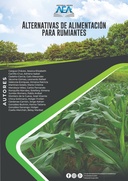Explore

Alternativas de alimentación para rumiantes
Jessica Elizabeth Cargua-Chávez, Adriana Isabel Carrillo-Cruz, Galo Alexander Cedeño-García, Leonardo Rafael Jácome-Gómez, Ximena Patricia Valencia-Enríquez, María Cristina Martínez-Sotelo, Carlos Fernando Mendoza-Vélez, Estefany Ximena Ronquillo-Narváez, Pablo Aníbal Jumbo-Romero, José Vicente Montero de la Cueva, Holger Froilán Chica-Solórzano, Jorge Adrian Cárdenas-Carrión, Karina Tatiana González-Buitrón, Holger González-Sanango, Betsy Maribel Coello-Merchán
2024
0 Ungluers have
Faved this Work
Login to Fave
Strategies to optimize ruminant feeding through the cultivation and management of different forages in Santo Domingo de los Tsáchilas, Ecuador, are examined. The first chapter highlights how liming and fertilization improve corn yields, with emphasis on optimal nutrient doses. The second chapter discusses organic fertilization of Mombasa grass under orange shade, highlighting the superiority of pollinaza in increasing yield and forage quality. The following chapters focus on the optimal cutting age to maximize biomass of Cuba OM-22 grass, the management of King Grass as a forage alternative for the livestock sector, and the development of hydroponic green forage from sorghum and corn at two planting densities, demonstrating that specific management and cultivation techniques can significantly influence the productivity and sustainability of ruminant feeding. Through these studies, the book proposes practical and sustainable solutions to improve ruminant nutrition in tropical environments.
This book is included in DOAB.
Why read this book? Have your say.
You must be logged in to comment.
